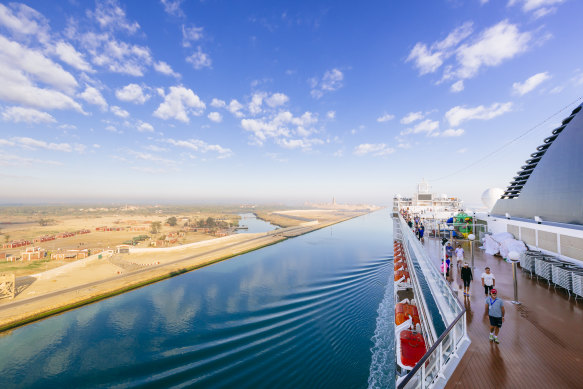Security concerns for cruises are spreading beyond the Red Sea
As Red Sea security deteriorates, cruise ships are abandoning the Suez Canal – with big implications for cruise itineraries.

Sailing the Suez – major issues for cruise lines and passengers.
The Red Sea is one of the world’s most important waterways, providing access between the Indian Ocean and Mediterranean Sea via the Suez Canal. Attacks on shipping by Iran-backed Houthi rebels have caused jitters and, as a result, risk-averse cruise ships are sensibly steaming for the horizon.
If you’re booked on a cruise itinerary that traverses the Red Sea any time this year, you should expect your cruise to be rerouted around Africa, or to sail on a brand-new itinerary elsewhere. If your cruise is imminent, it has most likely already been cancelled.
Cruise lines regularly use the Red Sea to redeploy ships from Europe to Asia at the end of the Mediterranean cruise season in October or November, and the reverse in March or April. And with that transit season now upon us, the list of cruise lines pulling out of the Red Sea has rapidly lengthened.
The earliest off the blocks was small-ship Greek company Variety Cruises in October 2023, whose owners clearly had a superior crystal ball. Silversea, MSC and German-founded company AIDA (now owned by Carnival Corporation) followed early this year. Virgin Voyages has cancelled its return to Australia next summer, citing the expense of returning from Europe via Africa.
The rest seemed to hesitate, but were probably scrambling to think of alternatives. Rearranging cruise itineraries isn’t easy. Port berths are booked well in advance, and cruise ships have far less flexibility than commercial vessels.
Many African ports don’t have tourism infrastructure or suitable catering supplies, or might have complicated passenger visa requirements.
The cancellations were bound to come, though. The Houthis explicitly vowed to attack shipping connected to Israel, Britain or the United States, and have launched numerous drone and missile attacks and attempted hijackings on trade ships in the Red Sea, which resulted in retaliation by Britain and the US on Houthi targets inside Yemen.
While few cruise ships are registered in the US (they are often registered in tax haven countries), many are American owned or perceived as American, and they present plump targets. With the March-April transit season looming, a spate of cruise ships was scheduled to use the Suez Canal, and something had to give.
The last weeks have seen a flotilla of ships abandon their Red Sea plans. Carnival Corporation and Royal Caribbean Group are among the most important, since their brands also include the likes of Celebrity, Cunard, Holland America, Princess, Seabourn and Silversea.
Expect to hear from your cruise company, if you haven’t already. The small print in cruise contracts often allows for cancellations or changes to schedules, for which you might be given future credits or discounts, or full refunds.
Don’t expect Red Sea and Suez Canal itineraries to return any time soon. In fact, the nervousness appears to be spreading. Some cruises in the wider Middle East that don’t visit the Red Sea at all are already affected. Princess has rerouted two world cruises, and Seabourn has cancelled a cruise between Hong Kong and Dubai. Watch this space.
EVERYONE ASKS
Which cruise lines are the eco-friendliest?
Let’s be honest: if you’re a committed eco-warrior you won’t be cruising. In fact, you’ll probably be picketing a cruise terminal. Good for you – public pressure can force big business to change.
For the rest of us, the somewhat good news is that cruise lines have been introducing better eco-technologies such as energy-efficient scrubbing, hybrid engines, waste recycling systems and solar panels. Many have banned plastics and started sourcing more local food.
Don’t get starry eyed. Such efforts don’t magic away cruising’s significant environmental impact. Your cruise choices might help, however. Select a small ship, since most run on cleaner marine gas oil rather than heavy fuel oil. And a newer one, for more up-to-date sustainability systems.
Your best bet is a small expedition ship. Lindblad has offered carbon-neutral cruises since 2019, and Ponant has some ships propelled by LNG that have zero emissions when in electric hybrid mode.
Hurtigruten has been setting new standards for eco-cruising, and polar specialist Aurora Expeditions has just become a Certified B Corporation for its environmental performance.
As an individual, you can reduce your footprint by controlling your cabin lighting and air-conditioning, reducing overall consumption – surely you can reuse that towel? – and wisely choosing shore excursions.
THE NUMBER
110
Maximum passengers on Uniworld’s two latest river-cruise ships SS Victoria and SS Elizabeth, which start sailing in Europe this year.
Sign up for the Traveller newsletter
The latest travel news, tips and inspiration delivered to your inbox. Sign up now.